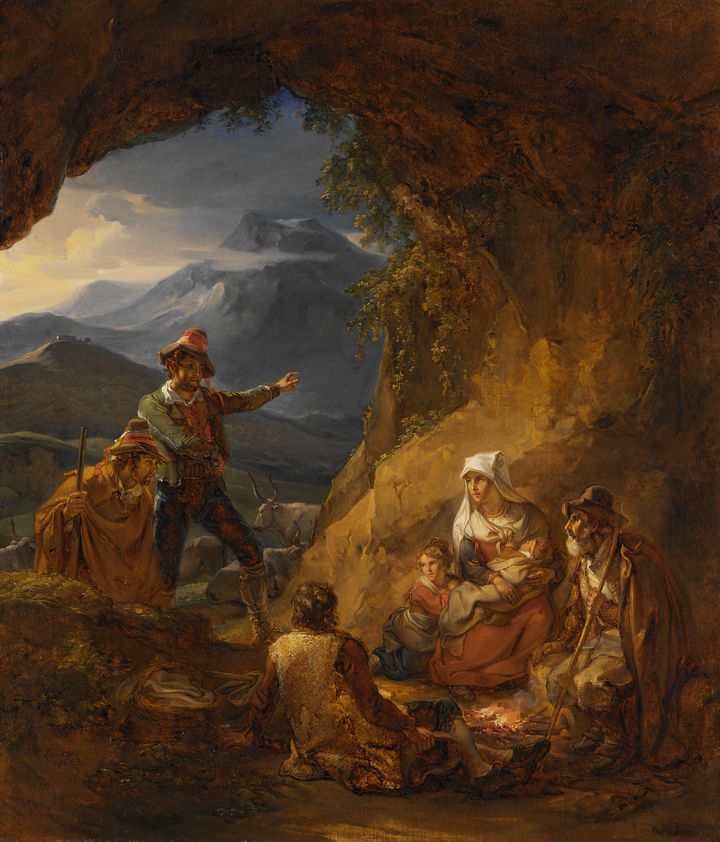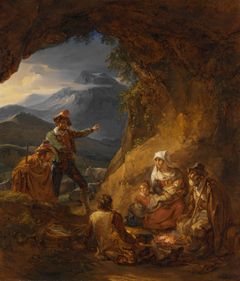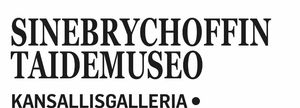Alexander Lauréus – To Rome 16 February 2023 – 20 August 2023 at the Sinebrychoff Art Museum

Alexander Lauréus (1783–1823)
Alexander Lauréus was born in Turku, where his artistic gifts were noted at an early stage. Aged just 19, he left for Stockholm to study at the Royal Swedish Academy. Upon completion of his studies, Lauréus made a successful career for himself as an art painter in Stockholm. His works were on display at the annual Academy exhibitions, and his clientele expanded year after year. In Stockholm Lauréus also met his life partner Charlotta Thynelius, with whom he lived in a common-law marriage. The couple travelled to Paris together in 1817.
In 1820 they continued their journey to Rome. The encounter with light, sun and Italian culture made a great impression on Lauréus, and his sojourn in Rome became the apex of his artistic output. Alexander Lauréus caught febrile illness in Rome and died in 1823 at just 40 years of age. He is buried in the Non-Catholic Cemetery in Rome.
Lauréus in Stockholm
For the young student, the move from Turku to the capital of the realm, Stockholm, was a big step. Lauréus visited the royal art collections and viewed the Dutch paintings of the seventeenth-century. Inspired by the Golden Age of Dutch art, Lauréus was interested in firelit scenes from early on. He specialized in depicting indoor scenes and landscapes lit by a candle, torch or open fire, and often by the moon. Many of the themes are familiar from older art: figures in a window, women at their daily chores, and learned men in the library. Lauréus became a pioneer of Romantic genre painting in Europe.
In Stockholm, Lauréus often depicted people of different social classes in squares, inns and wine cellars. He brought painting closer to the culture of entertainment. Ordinary people’s everyday life was still an unusual theme in painting of the day, nor was it much appreciated in the academic art world, which preferred ancient history and biblical themes. Lauréus depicted workers, soldiers and noble gentlemen, often in inns. The innkeepers and serving staff were generally women. In many works, they are the victims of male harassment, such as in the painting Hussars in an Inn (1810).
His works often contain humorous features. In the painting A Well-watered Man (1808), the gentlemen stumbling home with unsteady steps is a comic figure. His painting Party at the Parsonage (1815) is also humorous. The topic of the work is loosely based on Anna Maria Lenngren’s poem The Countess’s Visit (1810), about the visit of a countess and her daughter to a priest’s house. Lenngren highlights the comic effect produced when the priests and bourgeoisie try hopelessly to imitate and flatter the aristocracy.
Windows open to Europe
Lauréus travelled to Paris in 1817 with his life partner Charlotta Thynelius. In Paris, Lauréus depicted national celebrations, such as the revels in honour of the king in St Louis Celebration in Paris I and II (1819), as well as the disappearing folk culture, such as the street peddlers who had migrated from the countryside and were dressed in traditional costumes.
Lauréus’s workspaces in Paris were not suitable for oil painting; therefore, he did a large number of drawings there. One of the few oil paintings completed by Lauréus in Paris is A Rural Woman Selling Grapes to Savoyard Boys (1819). Lauréus had clearly used The Cherry Seller (1817) from the Cris de Paris series of Carle Vernet as a model.
After two and a half years in Paris, Lauréus continued towards Rome in the spring of 1820. The time in Rome was a period of strong creative power for Lauréus, and he painted his key works here.
Lauréus depicted Romans’ daily life. Paintings of ruins and monks tied in with Lauréus’s Romantic tradition. Il Vignaruolo or a Vine Grower’s Family (1822) is an idealized presentation of the simple life on the outskirts of Rome. The wonderful mastery of light shown in the paintings A Praying Monk (1822) and A Monk in a Ruin which Has Been Made into a Wine Cellar (1823) shows how far Lauréus’s technique had developed. Lauréus began to paint even larger paintings and in Rome his imagination took flight, as may be seen in his final, unfinished, work, Street View in Rome (1823).
Lauréus was highly praised for the depictions of folk life he painted in Italy, and the leading Swedish art collectors, such as Crown Prince Oscar and Count Gustaf Trolle-Bonde bought his works.
Curator of the exhibition: FM Lotta Nylund
Exhibition publication: Alexander Lauréus – Kohti Roomaa | Mot Rom | To Rome. Editor Ira Westergård. Contact: Parvs, hanna.karppanen@parvs.fi
Works have been generously loaned by: the Academic Society in Lund, Gothenburg Museum of Art, the Swedish Royal Collections, the National Museum in Stockholm, Stockholm City Museum, the University of Stockholm, Östergötland Museum,the Emil Aaltonen Art Collection, the Gösta Serlachius Fine Arts Foundation, Helsinki City Museum, the University of Helsinki, Nordea Art Foundation Finland, Pori Art Museum, the Reitz Foundation Collections, Turku Art Museum, Signe and Ane Gyllenberg foundation, private collections
More information on the exhibition:
Museum Director Kirsi Eskelinen, phone 0294 500 490 kirsi.eskelinen@siff.fi
Chief Curator Ira Westergård, phone 0294 500 473 ira.westergard@siff.fi
Press and media enquiries:
Marketing and Communications Specialist Katariina Hänninen, phone 0294 500 477 katariina.hanninen@siff.fi
Press Photos: https://press.sinebrychoffintaidemuseo.fi/en/media/alexander-laureus-to-rome
Upcoming events: https://sinebrychoffintaidemuseo.fi/en/calendar
Admission: 18 €/ 12 €, children under 18 free, Museum Card
Opening hours: Tue, Thu, Fri 11−18, Wed 11−20, Sat-Sun 10−17, Mondays closed
Guidance: sales@fng.fi
Contact: Sinebrychoff Art Museum, Bulevardi 40, 00120 Helsinki. Phone 0294 500 460 www.siff.fi
Facebook @siffmuseo | Instagram @Sinebrychoffartmuseum | Twitter @Sinebrychoffart
Sinebrychoff Art Museum is a part of the Finnish National Gallery, together with the Kiasma and the Ateneum Art Museum.
Keywords
Contacts
More information on the exhibition:
Museum Director Kirsi Eskelinen
phone 0294 500 490
kirsi.eskelinen@siff.fi
Chief Curator Ira Westergård
phone 0294 500 473
ira.westergard@siff.fi
Images
Links
About Sinebrychoffin Taidemuseo
Sinebrychoff Art Museum
Bulevardi 40
00120 Helsinki, Finland
Exchange
p. 0294 500 200
Info
phone. 0294 500 460
siffinfo@siff.fi
Subscribe to releases from Sinebrychoffin Taidemuseo
Subscribe to all the latest releases from Sinebrychoffin Taidemuseo by registering your e-mail address below. You can unsubscribe at any time.
Latest releases from Sinebrychoffin Taidemuseo
Inbjudan till utställningens förhandsvisning tisdagen den 11.2 kl. 14: Antikens hjältars äventyr och medryckande berättelser lockar publiken till Konstmuseet Sinebrychoff29.1.2025 08:00:00 EET | Pressmeddelande
På hjältarnas resa får vi uppleva fartfyllda och farliga situationer. Antikens hjälteberättelser underhåller oss fortfarande efter tusentals år och är starkt närvarande i vår kultur. Utställningen presenterar centrala hjältar i den grekiska mytologin. Följ med på äventyret! Välkommen på utställningens förhandsvisning tisdagen den 11.2 kl 14.00. Anmäl dig till: merja.haikio@siff.fi
Kutsu näyttelyn ennakkoesittelyyn ti 11.2. klo 14: Antiikin sankareiden seikkailut ja koukuttavat tarinat tempaavat mukaansa Sinebrychoffin taidemuseossa29.1.2025 08:00:00 EET | Tiedote
Sankareiden matkassa pääsemme kokemaan vauhtia ja vaarallisia tilanteita. Antiikin sankaritarinat viihdyttävät meitä vielä tuhansien vuosien jälkeen ja elävät vahvasti kulttuurissamme. Näyttely esittelee kreikkalaisen mytologian keskeiset sankarit. Lähde mukaan seikkailuun! Tervetuloa näyttelyn ennakkoesittelyyn ti 11.2.2025 klo 14.00. Ilmoittaudu mukaan: merja.haikio@siff.fi
You are invited to an exhibition preview at 14:00 on Tuesday, February 11. Gripping tales of ancient heroes and their adventures will captivate you at the Sinebrychoff Art Museum29.1.2025 08:00:00 EET | Press release
On the heroes’ journeys we get to experience action and perilous situations. Ancient hero tales still entertain us after thousands of years and live on strongly in our culture. The exhibition features the main heroes of Greek mythology. Join us on the adventure! You are welcome to the exhibition preview at 14.00 on Tuesday, 11.2.2025. Register: merja.haikio@siff.fi
Lyssna på antikens hjältesagor och försjunk i Spaniens myter på Konstmuseet Sinebrychoff under år 202519.12.2024 11:53:40 EET | Pressmeddelande
Under nästa år visar Konstmuseet Sinebrychoff två växlande utställningar. Först ut är Antikens hjältar. När vi följer med på hjältens resa får vi uppleva stora känslor och hisnande överraskningar. I september öppnar utställningen Spanien bakom myten som presenterar det kittlande Spanien och dess mytiska bildvärld. Utställningen visar målningar av spanska konstnärer från 1800- och 1900-talet.
Sinebrychoffin taidemuseossa kuullaan antiikin sankaritarinoita ja uppoudutaan myyttiseen Espanjaan vuonna 202519.12.2024 11:53:40 EET | Tiedote
Sinebrychoffin taidemuseossa on ensi vuonna esillä kaksi vaihtuvaa näyttelyä. Antiikin sankarit ovat ensimmäisenä näyttämöllä. Sankareiden matkassa pääsemme kokemaan suuria tunteita ja uskomattomia juonenkäänteitä. Syyskuussa avautuva Espanja myyttien takaa -näyttely esittelee kiehtovaa Espanjaa ja sen myyttistä kuvastoa. Näyttelyssä nähdään espanjalaisten taiteilijoiden maalauksia 1800-1900-luvuilta.
In our pressroom you can read all our latest releases, find our press contacts, images, documents and other relevant information about us.
Visit our pressroom

